"The city as an avatar of itself"
"It's often hard to convince people that Olivo Barbieri's aerial photographs are real," Metropolis writes.
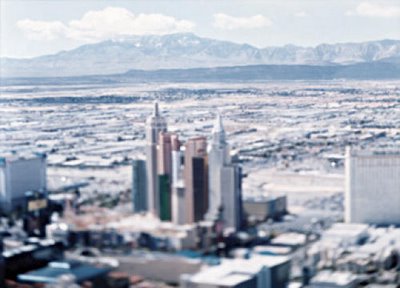
"They look uncannily like hyperdetailed models, absent the imperfections of reality. Streets are strangely clean, trees look plastic, and odd distortions of scale create the opposite effect of what we expect from aerial photography – a complete overview, like military surveillance."
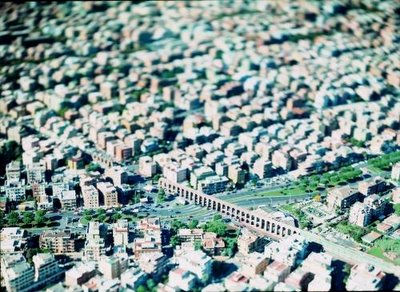
Barbieri "achieves the distinctive look by photographing from a helicopter using a tilt-shift lens – a method, he says, that 'allows me to choose what I really like in focus: like in a written page, we don't read [it as an] image but one line at a time.'"
It's geology disguised as sculpted chocolate; a Claymation paradise. Herculean examples of American civic infrastructure look like nothing more than cardboard, flimsy and ridiculous. (Amazingly, the second image, below, is a photograph of Hoover Dam).

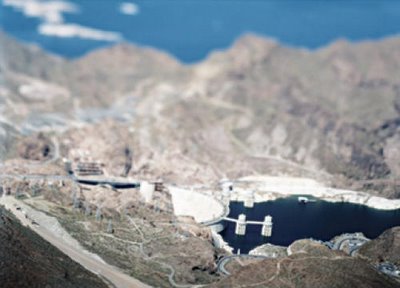
"For Barbieri," Metropolis says, "it is 'the city as an avatar of itself.'" So if he did take photos of city models someday... would they look real?
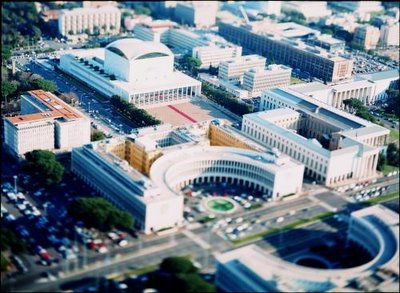
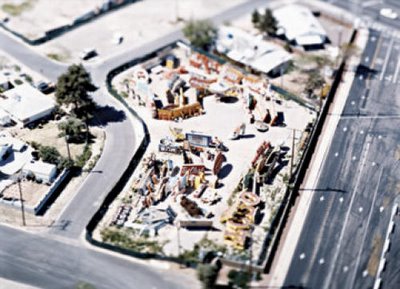
I'm left wondering what this techique would achieve in the field of human portraiture. The blurred heads of Francis Bacon meet some kind of plasticized mannequinization of the subject... Pickman's Model.
The results could be horrific.
(See also BLDGBLOG's look at the work of Oliver Boberg; and click here for another photo by Barbieri. Meanwhile, thanks to Brent Kissel for the initiating email! Thanks, as well, to Dan who I think might have mentioned Barbieri once...).

"They look uncannily like hyperdetailed models, absent the imperfections of reality. Streets are strangely clean, trees look plastic, and odd distortions of scale create the opposite effect of what we expect from aerial photography – a complete overview, like military surveillance."

Barbieri "achieves the distinctive look by photographing from a helicopter using a tilt-shift lens – a method, he says, that 'allows me to choose what I really like in focus: like in a written page, we don't read [it as an] image but one line at a time.'"
It's geology disguised as sculpted chocolate; a Claymation paradise. Herculean examples of American civic infrastructure look like nothing more than cardboard, flimsy and ridiculous. (Amazingly, the second image, below, is a photograph of Hoover Dam).


"For Barbieri," Metropolis says, "it is 'the city as an avatar of itself.'" So if he did take photos of city models someday... would they look real?


I'm left wondering what this techique would achieve in the field of human portraiture. The blurred heads of Francis Bacon meet some kind of plasticized mannequinization of the subject... Pickman's Model.
The results could be horrific.
(See also BLDGBLOG's look at the work of Oliver Boberg; and click here for another photo by Barbieri. Meanwhile, thanks to Brent Kissel for the initiating email! Thanks, as well, to Dan who I think might have mentioned Barbieri once...).

Comments are moderated.
If it's not spam, it will appear here shortly!
check out the adorable/horrifying child portraiture of Loretta Lux.
Jimmy, that's insane - I literally just received a postcard featuring Lux's Troll 2... Seriously. Well, two-three weeks ago, but still.
This might be a case of 'who did it first?' Tom Merilion has a very similar approach to Birmingham, England. Is one a former student of the other? Both arriving at the same technique independently? In any case, Tom's images, a couple of feet on a side, are definitely a pleasure to look at. Presumable that same can be said of Olivo's.
what's interesting to me isn't so much 'who did it first' (really, who cares? enough with the nitpicking over artistic/intellectual genealogies and origins. let's just say it all happened in one great, absurd, risible moment.) but rather that the subject is the city--or the built environment/structure . yes, city as avatar. or photograph as synecdoche. the thing that stands in for something else. but in a non-mimetic manner. i wonder what daguerre would say. daguerre, who only 150+ yrs ago, found it fit to begin his experimentation with photographing by imaging the urbanscape of pa-ree. what is the impulse? what is this urge to make physical and visible (doubly so) the image of the city?
sdm - Check out BLDGBLOG's post on Liz Hickok...
And nice links, meanwhile, above; thanks! May add some of those images.
I was coming in here to mention Rader as well -- silly me, thinking I could beat the BLDGBLOG crowd to the punch. But as re: a swing/tilt lens, you see them used all the time -- just not in landscape photography. Know the beer bottles where they've somehow managed to focus on the bead of beer-sweat while naking the rest of the bottle fuzzily alluring? Swing-&-tilt. Gourmet magazine covers, where they manage to make the back end of a triple-layer-arugula-ganache-chocolate cake fade into an almost horizon-like distance? Swing-&-tilt. It just took Rader and Barbieri to think of taking one up in a helicopter to plasticize a city (or in Rader's case, one of the Insta-Cities that sprawl out from Barbieri's Extant Cities). It's as if they agreed to divvy it up: Marc, I get the urb, you get the exurb.
Another photographer who uses similar techniques: Miklos Gaál.
A friend of mine takes tilt/shift shots too, check it out here: Tilt/Shift
Feckin 'ell! I'm beginning to feel left out for not having a buch of T/Z photos online. So here's what I've done: y'all recall the 'average' photos of some time last year, right? Well, I did a bunch of those, and luckily, some of them have a tilt aspect and a zoom aspect to them. For example, here's one of some local shops and buildings. They don't have that fresh out-of-the-box look, but that's probably an effect of the averaging.
I find Barbieri's Santa Monica pier and Paris/Las Vegas images to be particularly luscious. Their sweet crushability, like tiny sugar sculptures on the glossy cover of your favorite gourmet confectioner's mag. Waves all rippled like icing. Eiffel Tower replica built of crispy wafers, press-punched into delicate filigrees.
Does anyone else get hungry from these photos?
On technique: could you pull off the tilt/shift look by stalling out your helicopter engine, plummeting towards the subject?
Okay, so I made the mistake of calling it tilt/zoom instead of tilt shift. A few hours later I have seen a bunch of T/S photos including my favourite in this pool at flickr. I also have some ideas about how to achieve the effect digitally - not that it would resemble anything seen here, of course. As for portraits, Lensbaby and bluejake have enough to get a general idea of what happens...
This reminds me of those real-estate models of new communities ~ kudos
That's amazing thanks. Reminds me of those little models used by Dr. Evil. ;-)
i took a picture from an airplane window once that strangely had this efffect. i think it turned out so because the window was kinda dirty and blurry.
i think this effect could be acieved by heavy use of a vignette'd soft focus. i create the soft focus effect by with a gaussian blurred layer.
anyway, here is the picture i took that resembles this effect:
Over turkey
Wow! Does anyone here suffer from depersonalization/derealization (DP/DR)? It's uncanny how similar these pictures are to what I see every day.
Imagine what it's like for me to drive.
"Depersonalization is caused by a shift in the part of the brain that provides us with a 'real' awareness of our environment; this part of the brain is directly linked to the Amygdala, the organ in the brain responsible for anxiety. Depersonalization can include feelings of being:
• unreal
• disembodied
• unattached
• dead
• puppet-like
• robot-like
• like a lifeless, two dimensional, 'cardboard figure'
• made of cotton-wool
• having mechanical actions
• a spectator"
Etc. But I love that you can feel like you're "made of cotton-wool." Some people would actually take pills not to get rid of that - but to induce it.
"Unlike depersonalization which effects the perception of oneself, derealization is a change in an individual's experience of their environment, where the world around him/her feels unreal and unfamiliar... Sufferers describe derealization as:
• spaciness like in a dream
• like looking through a veil
• a sensory fog, spaced-out
• in a goldfish bowl
• behind glass
• withdrawn
• flat
• dream-like"
So I'm left wondering if you could build a city of the derealized, where everyone suffers panic attacks - because the architecture is flat, undetailed, monolithic. Like Las Vegas sprawl - or the suburbs. Is there a higher instance of "derealization" in neighborhoods built by Toll Brothers, for instance...? And if a study could prove that, would Toll Brother sue the authors for libel...?
This is actually a well documented phenomenon. If you make the focal distance of your camera much, much larger then the human focal distance (around a foot between eyeballs), say 50 yards or so, you'll end up with photos that look like this. Then you run into the second part of the coolness. Your brain knows that the eye's ability to focus is pretty small (meaning, that only the middle of your area of vision is in clear focus, with more and more fuzziness as you approach the periphery). It turns out that your brain uses this increasing fuzziness to determine scale of objects. So, if you see anything of large size that is completely in focus, your mind says to itself "this must actually be very small, like a model, since it's all in focus at the same time".
Those are so detailed...
chech out this page of romanian photographer cosmin bumbutz. the series is called tilted people:
http://bumbutz.ro/sessions/8/show.php?p=title
As I don't see it linked here yet: check out this nice series of Japanese pictures made with a similar technique.
Those are some awesome photos. Im going to go and find out a method of creating these so I can play too :)
I've just begun to play aound with this technique and have had varying degrees of success.
A few work, a few don't, but I've only been trying for a few hours.
More, and hopefully better, examples when i get the time.
http://z6.co.uk/index.php?itemid=16
Post a Comment